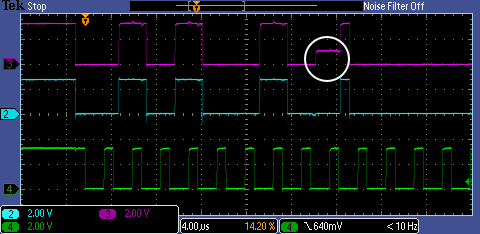Hi,
I'm using a TXS0108E to level shift I2C between 2V8 (on A side) and 3V3 (on B side). When an I2C slave on the A side pulls low to 0V, the B side drops as far as 1.2V but no further. There are no external pull-ups and the I2C clock is 400KHz. It looks to me like the Npass transistor is off. I can't find any documentation showing where the Npass bias voltage comes from but I guess it's from Vccb and so the transistor should be on. The OE pin is connected direct to Vcca at 2V8.
The traces below show SDA on the A side in blue and SDA on the B side in purple. At the point marked by the white circle, the slave is pulling 0V (I2C ACK) on the A side but the B side is stuck at 1.2V when it should be 0V. This is a low-to-low transition but the same is true for a high-to-low transition i.e. the B side low gets no further down than 1.2V.
Would be interested to know if anyone else has seen something similar and what can be done about it.
Thanks,
Paul


